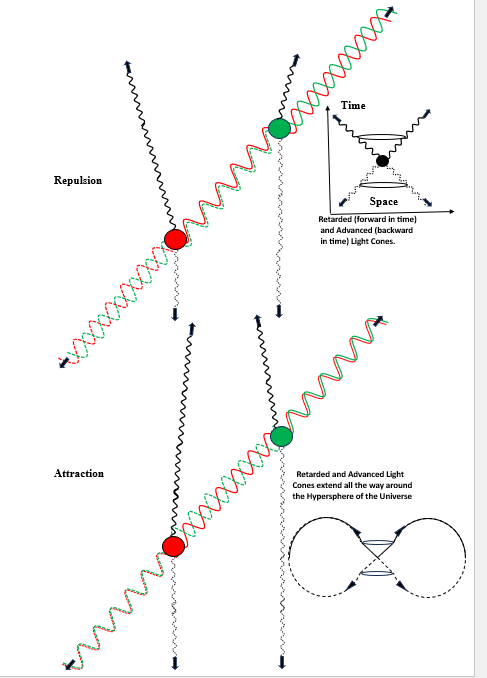TIQM and Hypersphere Cosmology.
Abstract.
A conceptual scheme for the unification of the Transactional Interpretation of Quantum Mechanics with Hypersphere Cosmology that may model both repulsive and attractive forces between quanta.

Diagrams: -
Upper Right – The Transactional Interpretation of Quantum Mechanics (TIQM) asserts that an energy exchange consists of a ‘quantum handshake’ between an emitter and an absorber in which both emit a retarded (forward in time) and an advanced (backward in time) wave.
We can envisage the so called Null-Paths of the retarded and advanced waves as forming forward and backward Light Cones where the spacetime interval ((s2 + (ict2))1/2 = 0.
Upper Central – The TIQM model of a photon passing from an emitter (red spot) to a receiver (green spot) with both recoiling.
Note that a ‘complete photon exchange’ has both ‘particle’ and ‘antiparticle’ wave components in phase giving it a spin of twice that of a matter quantum. This event occurs only along a Spacetime Null-Path between the emitter and the absorber. Once established the wave function collapses instantaneously at all points along the null path to complete the exchange of a quantum of energy. Beyond the emitter and the absorber, the wave components lie in antiphase resulting in negation of the wave functions or ‘field excitations’.
TIQM accounts for the observed phenomena of quantum superposition and entanglement by positing the retro causal effects of advanced waves traveling backwards in time down the emission path to modify the emission conditions.
In TIQM the mutual reinforcement of retarded offer wave and advanced confirmation wave builds up in Pseudo-Time, but it appears instantaneous in ordinary observed time.
It seems reasonable to make two further assertions, firstly that pseudo time lies somehow orthogonal to ordinary observed time, and secondly that so called ‘virtual’ energy ‘particles’ consist of partial quantum handshakes that do not have enough energy to achieve the exchange of a complete quantum of energy.
Such ‘virtual particle’ exchanges dominate much of the structure of the universe in such processes as electromagnetic attraction and repulsion and perhaps also in the action of static gravitational fields.
Examples of repulsive effects – by ‘real’ quanta e.g., photons and perhaps ‘gravitational waves’. By ‘virtual’ photons e.g., electromagnetic repulsion.
Lower Central. – Attractive forces between quanta have always presented a problem of apparent ‘action at a distance’, for how can two objects attract each other if they have to do so by passing something carrying momentum between them? This led to speculation from Newton’s time onwards about Shadow Gravity theories in which a universal mutual ‘push’ between all bodies in the universe becomes shielded by bodies in relative proximity leading to a net attractive effect between them. Such theories however run into problems with thermodynamics.
In the lower central diagram, apparently attractive forces arise between quanta when the retarded and advanced waves between the quanta combine in a state of anti-phase cancellation and the retarded and advanced waves beyond the particles combine reinforcingly in phase to carry momentum away from the quanta in directions that effectively push them towards each other.
Examples of attractive effects – by ‘virtual’ quanta e.g., electromagnetic attraction and perhaps static field gravitational attraction.
Lower Right. – In a Hyperspherical universe the retarded (forward in time) and advanced (backwards in time) lightcones of all matter meet at antipode distance, as do the wave functions of the matter quanta themselves.
We can thus conceptualise attractive effects as arising from repulsive effects acting right round the hypersphere of the universe.
In General. - Quanta exist as ‘Particles’ only fleetingly at the instant of interaction. Between interactions they do not have well defined positions and momenta when traveling as waves in space and time between interaction events.
Ordinary matter owes its apparent constant persistence to highly frequent interactions between its constituent quanta, yet between interactions the constituent quanta do not have counterfactual (unobserved but assumed) definiteness.